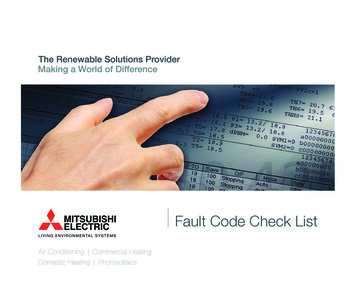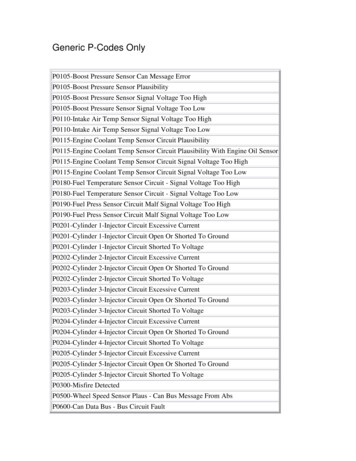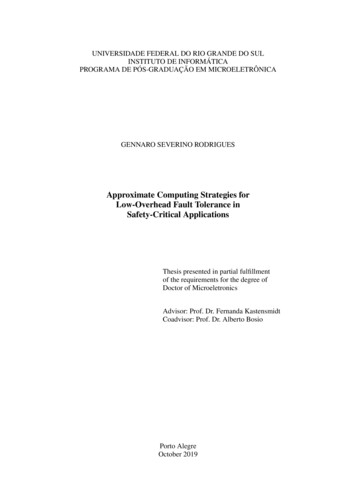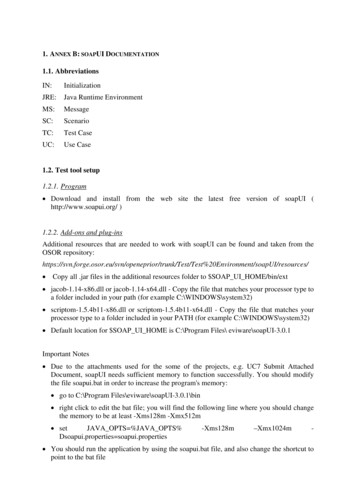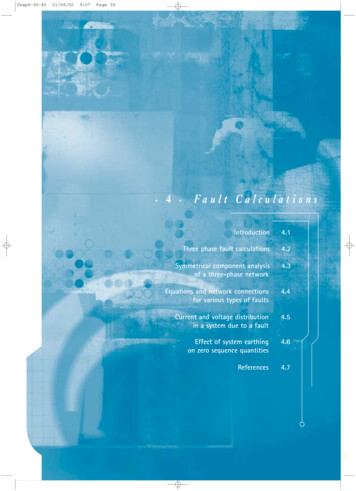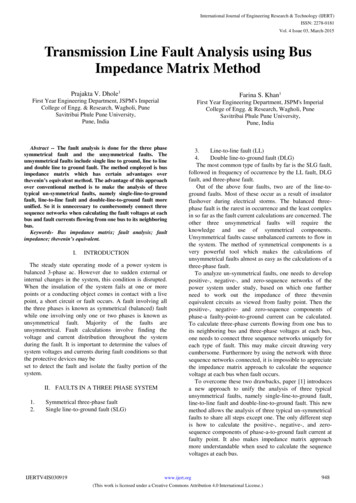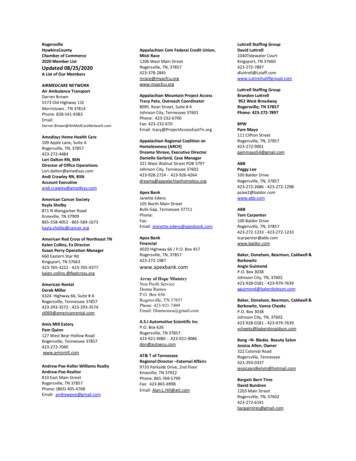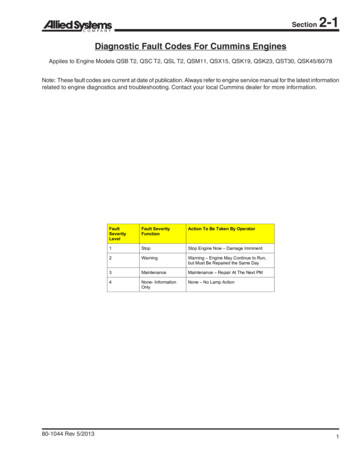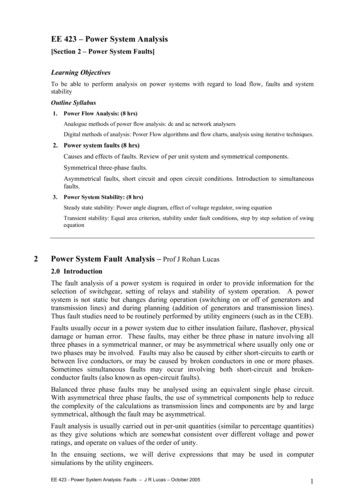
Transcription
EE 423 – Power System Analysis[Section 2 – Power System Faults]Learning ObjectivesTo be able to perform analysis on power systems with regard to load flow, faults and systemstabilityOutline Syllabus1.Power Flow Analysis: (8 hrs)Analogue methods of power flow analysis: dc and ac network analysersDigital methods of analysis: Power Flow algorithms and flow charts, analysis using iterative techniques.2. Power system faults (8 hrs)Causes and effects of faults. Review of per unit system and symmetrical components.Symmetrical three-phase faults.Asymmetrical faults, short circuit and open circuit conditions. Introduction to simultaneousfaults.3.Power System Stability: (8 hrs)Steady state stability: Power angle diagram, effect of voltage regulator, swing equationTransient stability: Equal area criterion, stability under fault conditions, step by step solution of swingequation2Power System Fault Analysis – Prof J Rohan Lucas2.0 IntroductionThe fault analysis of a power system is required in order to provide information for theselection of switchgear, setting of relays and stability of system operation. A powersystem is not static but changes during operation (switching on or off of generators andtransmission lines) and during planning (addition of generators and transmission lines).Thus fault studies need to be routinely performed by utility engineers (such as in the CEB).Faults usually occur in a power system due to either insulation failure, flashover, physicaldamage or human error. These faults, may either be three phase in nature involving allthree phases in a symmetrical manner, or may be asymmetrical where usually only one ortwo phases may be involved. Faults may also be caused by either short-circuits to earth orbetween live conductors, or may be caused by broken conductors in one or more phases.Sometimes simultaneous faults may occur involving both short-circuit and brokenconductor faults (also known as open-circuit faults).Balanced three phase faults may be analysed using an equivalent single phase circuit.With asymmetrical three phase faults, the use of symmetrical components help to reducethe complexity of the calculations as transmission lines and components are by and largesymmetrical, although the fault may be asymmetrical.Fault analysis is usually carried out in per-unit quantities (similar to percentage quantities)as they give solutions which are somewhat consistent over different voltage and powerratings, and operate on values of the order of unity.In the ensuing sections, we will derive expressions that may be used in computersimulations by the utility engineers.EE 423 - Power System Analysis: Faults – J R Lucas – October 20051
2.1 Equivalent Circuits - Single phase and Equivalent Single Phase CircuitsIn a balanced three phase circuit, since the information relating to one single phase givesthe information relating to the other two phases as well, it is sufficient to do calculations ina single phase circuit. There are two common forms used. These are (i) to take any onesingle phase of the three phase circuit and (ii) to take an equivalent single phase circuit torepresent the full three phase circuit.2.1.1 Single Phase CircuitAIP IASZsPT/3EANVP VASZSFigure 2.1 - Single Phase CircuitFigure 2.1 shows one single phase “AN” of the three phase circuit “ABC N”. Since thesystem is balanced, there is no current in the neutral, and there is no potential drop acrossthe neutral wire. Thus the star point “S” of the system would be at the same potential asthe neutral point “N”. Also, the line current is the same as the phase current, the linevoltage is 3 times the phase voltage, and the total power is 3 times the power in a singlephase.I IP IL, V VP VL/ 3 and S SP ST/3Working with the single phase circuit would yield single phase quantities, which can thenbe converted to three phase quantities using the above conversions.2.1.2 Equivalent Single Phase CircuitOf the parameters in the single phase circuit shown in figure 2.1, the Line Voltage and theTotal Power (rather than the Phase Voltage and one-third the Power) are the mostimportant quantities. It would be useful to have these quantities obtained directly from thecircuit rather than having conversion factors of 3 and 3 respectively. This is achieved inthe Equivalent Single Phase circuit, shown in figure 2.2, by multiplying the voltage by afactor of 3 to give Line Voltage directly.AZsI 3 IL 3 IASVL 3VASPT ZEL 3EANSFigure 2.2 - Equivalent Single Phase CircuitThe Impedance remains as the per-phase impedance. However, the Line Current gets2artificially amplified by a factor of 3. This also increases the power by a factor of ( 3) ,which is the required correction to get the total power.Thus, working with the Equivalent single phase circuit would yield the required threephase quantities directly, other than the current which would be 3 IL.EE 423 - Power System Analysis: Faults – J R Lucas – October 20052
2.2 Revision of Per Unit QuantitiesPer unit quantities, like percentage quantities, are actually fractional quantities of areference quantity. These have a lot of importance as per unit quantities of parameters tendto have similar values even when the system voltage and rating change drastically. The perunit system permits multiplication and division in addition to addition and subtractionwithout the requirement of a correction factor (when percentage quantities are multipliedor divided additional factors of 0.01 or100 must be brought in, which are not in the originalequations, to restore the percentage values). Per-unit values are written with “pu” after thevalue.For power, voltage, current and impedance, the per unit quantity may be obtained bydividing by the respective base of that quantity.S pu SS baseV pu VVbaseI pu IZ pu I baseZZ baseExpressions such as Ohm’s Law can be applied for per unit quantities as well. SinceVoltage, Current, Impedance and Power are related, only two Base or reference quantitiescan be independently defined. The Base quantities for the other two can be derived therefrom. Since Power and Voltage are the most often specified, they are usually chosen todefine the independent base quantities.2.2.1 Calculation for Single Phase SystemsIf VAbase and Vbase are the selected base quantities of power (complex, active or reactive)and voltage respectively, thenBase currentI base Vbase I base VAbase VbaseVbaseBase ImpedanceZ base VbaseV 2 baseV 2 base I base I baseVbase VAbaseIn a power system, voltages and power are usually expressed in kV and MVA, thus it isusual to select an MVAbase and a kVbase and to express them as Base currentI baseBase ImpedanceZ base MVAbasekVbase2kVbaseMVAbasein kA,[Q 106/103 103]in Ω,[Q (103)2/106 1]In these expressions, all the quantities are single phase quantities.2.2.2 Calculations for Three Phase SystemsIn three phase systems the line voltage and the total power are usually used rather than thesingle phase quantities. It is thus usual to express base quantities in terms of these.If VA3φbase and VLLbase are the base three-phase power and line-to-line voltage respectively,Base currentBase ImpedanceI base Z baseVA3φbaseVAbase 3VAbase Vbase3Vbase3VLLbaseV 2base VAbase( 3) V22base3VAbaseEE 423 - Power System Analysis: Faults – J R Lucas – October 2005 V 2 LLbaseVA3φbase3
and in terms of MVA3φbase and kVLLbaseMVA3φbase Base currentI baseBase ImpedanceZ base in kA3kVLLbase2kVLLbaseMVA3φbasein ΩIt is to be noted that while the base impedance for the three phase can be obtained directlyfrom the VA3φbase and VLLbase (or MVA3φbase and kVLLbase) without the need of any additionalfactors, the calculation of base current needs an additional factor of 3. However this isnot usually a problem as the value of current is rarely required as a final answer in powersystems calculations, and intermediate calculations can be done with a variable 3Ibase.Thus in three phase, the calculations of per unit quantities becomesS pu S actual ( MVA),MVA3φbaseV pu Vactual (kV),kVLLbaseI pu I actual (kA).Z pu Z actual (Ω) .3kVLLbaseMVA3φbaseandMVA3φbase2kVLLbaseP and Q have the same base as S, so thatPpu Pactual ( MW ), Q pu MVA3φbaseQactual ( Mvar)MVA3φbaseSimilarly, R and X have the same base as Z, so thatR pu Ractual (Ω) .MVA3φbasekV2LLbase,X pu X actual (Ω) .MVA3φbase2kVLLbaseThe power factor remains unchanged in per unit.2.2.3 Conversions from one Base to anotherIt is usual to give data in per unit to its own rating [ex: The manufacturer of a certain pieceof equipment, such as a transformer, would not know the exact rating of the power systemin which the equipment is to be used. However, he would know the rating of hisequipment]. As different components can have different ratings, and different from thesystem rating, it is necessary to convert all quantities to a common base to do arithmetic oralgebraic operations. Additions, subtractions, multiplications and divisions will givemeaningful results only if they are to the same base. This can be done for three phasesystems as follows.MVA3φbaseGivenkVS puNew S puGiven ., V puNew V puGiven . LLbaseGiven , andMVA3φbaseNewkVLLbaseNewZ pu Z puGiven .2MVA3φbaseNew kV LLbaseGiven.2MVA3φbaseGiven kV LLbaseNewEE 423 - Power System Analysis: Faults – J R Lucas – October 20054
Example:A 200 MVA, 13.8 kV generator has a reactance of 0.85 p.u. and is generating 1.15 puvoltage. Determine (a) the actual values of the line voltage, phase voltage and reactance,and (b) the corresponding quantities to a new base of 500 MVA, 13.5 kV.(a)Line voltage 1.15 * 13.8 15.87 kVPhase voltage 1.15 * 13.8/ 3 9.16 kV 0.85 * 13.82/200 0.809 ΩLine voltage 1.15 * 13.8/13.5 1.176 puReactance(b)Phase voltage 1.15 * (13.8/ 3)/(13.5/ 3)Reactance 1.176 pu2 0.85 * (13.8/13.5) /(500/200) 0.355 pu2.2.4 Per Unit Quantities across TransformersWhen a transformer is present in a power system, although the power rating on either sideof a transformer remains the same, the voltage rating changes, and so does the base voltageacross a transformer. [This is like saying that full or 100% (or 1 pu) voltage on theprimary of a 220kV/33 kV transformer corresponds to 220 kV while on the secondary itcorresponds to 33 kV.] Since the power rating remains unchanged, the impedance andcurrent ratings also change accordingly.While a common MVA3φbase can and must be selected for a power system to do analysis, acommon VLLbase must be chosen corresponding to a particular location (or side oftransformer) and changes in proportion to the nominal voltage ratio whenever atransformer is encountered. Thus the current base changes inversely as the ratio. Hencethe impedance base changes as the square of the ratio.For a transformer with turns ratio NP:NS, base quantities change as follows.QuantityPrimary BaseSecondary BasePower (S, P and Q)SbaseSbaseVoltage (V)V1baseV1base . NS/NPCurrent (I)Sbase/ 3V1baseImpedance (Z, R and X)Example :GG2V1base /Sbase V2baseSbase/ 3V1base . NP/NS2V1base /Sbase . (NS/NP)2Transmission LineT1Figure 2.3 - Circuit for Example Sbase/ 3V2base V2base2/SbaseLoadT2In the single line diagram shown in figure 2.3, each three phase generator G is rated at 200MVA, 13.8 kV and has reactances of 0.85 pu and are generating 1.15 pu. Transformer T1is rated at 500 MVA, 13.5 kV/220 kV and has a reactance of 8%. The transmission linehas a reactance of 7.8 Ω. Transformer T2 has a rating of 400 MVA, 220 kV/33 kV and areactance of 11%. The load is 250 MVA at a power factor of 0.85 lag. Convert allquantities to a common base of 500 MVA, and 220 kV on the line and draw the circuitdiagram with values expressed in pu.EE 423 - Power System Analysis: Faults – J R Lucas – October 20055
Solution:The base voltage at the generator is (220*13.5/220) 13.5 kV, and on the load side is(220*33/220) 33 kV. [Since we have selected the voltage base as that corresponding to thevoltage on that side of the transformer, we automatically get the voltage on the other sideof the transformer as the base on that side of the transformer and the above calculation is infact unnecessary.Generators GReactance of 0.85 pu corresponds 0.355 pu on 500 MVA, 13.5 kV base (see earlierexample)Generator voltage of 1.15 corresponds to 1.176 on 500 MVA, 13.5 kV baseTransformer T1Reactance of 8% (or 0.08 pu) remains unchanged as the given base is the same as the newchosen base.Transmission LineReactance of 7.8 Ω corresponds to 7.8 * 500/2202 0.081 puTransformer T2Reactance of 11% (0.11 pu) corresponds to 0.11 * 500/400 0.1375 pu(voltage base is unchanged and does not come into the calculations)LoadLoad of 250 MVA at a power factor of 0.85 corresponds to 250/500 0.5 pu at a powerfactor of 0.85 lag (power factor angle 31.79 ) resistance of load 0.5 * 0.85 0.425 puand reactance of load 0.5 * sin 31.79 0.263 puThe circuit may be expressed in per unit as shown in figure 2.4.1.176 puj0.3551.176 puj0.355j0.08j0.081j0.1380.425 j0.263Figure 2.4 - Circuit with per unit values2.3 Symmetrical Three Phase Fault AnalysisA three phase fault is a condition where either (a) all three phases of the system are shortcircuited to each other, or (b) all three phase of the system are earthed.3 φ faultSupplyside3 φ to earth faultabaSupplysidebcFigure 2.5a – Balanced three phase faultcFigure 2.5b – Balanced three phase fault toThis is in general a balanced condition, and we need to only know the positive-sequencenetwork to analyse faults. Further, the single line diagram can be used, as all three phasescarry equal currents displaced by 120o.EE 423 - Power System Analysis: Faults – J R Lucas – October 20056
Typically, only 5% of the initial faults in a power system, are three phase faults with orwithout earth. Of the unbalanced faults, 80 % are line-earth and 15% are double line faultswith or without earth and which can often deteriorate to 3 phase fault. Broken conductorfaults account for the rest.2.3.1 Fault Level CalculationsIn a power system, the maximum the fault current (or fault MVA) that can flow into a zeroimpedance fault is necessary to be known for switch gear solution. This can either be thebalanced three phase value or the value at an asymmetrical condition. The Fault Leveldefines the value for the symmetrical condition. The fault level is usually expressed inMVA (or corresponding per-unit value), with the maximum fault current value beingconverted using the nominal voltage rating.MVAbase 3 . Nominal Voltage(kV) . Ibase (kA)MVAFault 3 . Nominal Voltage(kV) . Isc (kA)whereMVAFault – Fault Level at a given point in MVAIbase– Rated or base line currentIsc– Short circuit line current flowing in to a faultThe per unit value of the Fault Level may thus be written asFault Level 3 . Nominal Voltage . I sc3 . Nominal Voltage . I base 3I sc3I base I sc , pu V No min al , puZ puThe per unit voltage for nominal value is unity, so thatFault Level ( pu ) 1,Z puFault MVA Fault Level ( pu ) MVAbase MVAbaseZ puThe Short circuit capacity (SCC) of a busbar is the fault level of the busbar. The strengthof a busbar (or the ability to maintain its voltage) is directly proportional to its SCC. Aninfinitely strong bus (or Infinite bus bar) has an infinite SCC, with a zero equivalentimpedance and will maintain its voltage under all conditions.Magnitude of short circuit current is time dependant due to synchronous generators. It isinitially at its largest value and decreasing to steady value. These higher fault levels taxCircuit Breakers adversely so that current limiting reactors are sometimes used.The Short circuit MVA is a better indicator of the stress on CBs than the short circuitcurrent as CB has to withstand recovery voltage across breaker following arc interruption.The currents flowing during a fault is determined by the internal emfs of machines in thenetwork, by the impedances of the machines, and by the impedances between themachines and the fault.Figure 2.6 shows a part of a power system, where the rest of the system at two points ofcoupling have been represented by their Thevenin’s equivalent circuit (or by a voltagesource of 1 pu together its fault level which corresponds to the per unit value of theeffective Thevenin’s impedance).EE 423 - Power System Analysis: Faults – J R Lucas – October 20057
Fault Level 8 puFault Level 5 pu12Z1 0.3 puZ2 0.3 puCB2CB13IFFaultFigure 2.6 – Circuit for Fault Level CalculationWith CB1 and CB2 open, short circuit capacities areSCC at bus 1 8 p.u. gives Zg1 1/8 0.125 puSCC at bus 2 5 p.u. gives Zg2 1/5 0.20 puEach of the lines are given to have a per unit impedance of 0.3 pu.Z1 Z2 0.3 p.u.With CB1 and CB2 closed, what would be the SCCs (or Fault Levels) of the busbars in thesystem ?o0.3 puZin0.2 pu0.125 pu1V3V 1 puV 1 pu30.3 pu 23ZfZfSystem Equivalent CircuitThevenin’s Equivalent at 3Figure 2.7a Determination of Short circuit capacitiesThis circuit can be reduced and analysed as in figure 2.7b.0.4250.425 3 0.5E 1 E 10.23 Bus3Bus3 0.51Figure 2.7b Determination of Short circuit capacity at Bus 3Thus, the equivalent input impedance is given by to give Zin as 0.23 pu at bus 3,so that the short circuit capacity at busbar 3 is given as SCC3 1/0.23 4.35 p.uThe network may also be reduced keeping the identity of Bus 1 as in figure 2.7c.0.125E 10.1251 0.8E 1 0.8Bus1 0.108 Bus11Figure 2.7c Determination of Short circuit capacity at Bus 1EE 423 - Power System Analysis: Faults – J R Lucas – October 20058
Thus, the equivalent input impedance is given by to give Zin as 0.108 pu at bus 1, so thatthe short circuit capacity at busbar 1 is given as SCC1 1/0.108 9.25 p.uThis is a 16% increase on the short circuit capacity of bus 1 with the circuit breakers open.The network may also be reduced keeping the identity of Bus 2. This would yield a valueof Zin as 0.157 pu, giving the short circuit capacity at busbar 2 as SCC2 1/0.157 6.37 p.uThis is a 28% increase on the short circuit capacity of bus 2 with the circuit breakers open.Typical maximum values of short circuit capacities at substations in Sri Lanka in 2000 areshown in table 2.1. Actual fault currents are lower than these values due to the presence offault impedance in the adampeMataraMatugamaNuwara 3435428628641763389697Puttalam 680572274463429183423509Average SCCStd deviationAverage Isc377 MVA166 MVA6.6 kATable 2.1 – Maximum 3φ Fault Levels at 33kV Substations in Sri Lanka in 20002.4 Fault Currents in synchronous machines14current(pu)12108Envelope of transient decayd.c. transient decaya.c. transient decay6420-2050100150200250time (ms)- - sub transient - - transient - - - - - - - - - - - - - - - - - - - steady state - -Figure 2.8 – Transient decay of current in synchronous generatorEE 423 - Power System Analysis: Faults – J R Lucas – October 20059
As mentioned earlier, the currents flowing in the power system network during a fault isdependant on the machines connected to the system. Due to the effect of armature currenton the flux that generates the voltage, the currents flowing in a synchronous machinediffers immediately after the occurrence of the fault, a few cycles later, and under sustainedor steady-state conditions.Further there is an exponentially decaying d.c. component caused by the instantaneousvalue at the instant of fault occurring. These are shown in figure 2.8.2.5current (pu)22.5current (pu)21.51.5110.50.500- 0.5-0.5-1-1- 1.5050100150-1.50200250time (ms)50100Figure 2.9a & b – Steady state and Transient current150200250time (ms)Figure 2.9a and 2.9b show the steady state current waveform, and the transient waveformof a simple R-L circuit, to show the decay in the d.c. component. In addition to this, in thesynchronous machine, the magnitude of the a.c. current peak also changes with time asshown in figure 2.9c, with the unidirection component of the transient waveform removed.currentcbao050100150200Figure 2.9c–Synchronous machine transient250Due to the initial low backemf at the instant of faultresulting in high current, theeffective impedance is verylow. Even when the d.c.transient component is notpresent, the initial currentcan be several times thesteady state value.Thusthree regions are identifiedfordeterminingthereactance. These are the subtransient reactance xd” for thefirst 10 to 20 ms of fault, thetransient reactance xd' for upto about 500 ms, and thesteady state reactance xd(synchronous reactance). The sub-transient mustusually be used in faultanalysis.time (ms)oa - peak value of steady state short-circuit currentob - peak value of transient short-circuit currentoc - peak value of sub-transient short-circuit currentEE 423 - Power System Analysis: Faults – J R Lucas – October 200510
The r.m.s. values of current are given bysubtransient transient steady-stateEoa I reactance reactance reactance2XdturboEob10-20 %15-25 % 150-230 % I′ generator2X d′salient-poleEoc15-25 %25-35 %70-120 % I ′′ generator2X d′′The typical generator reactance values are given above for reference.2.5 Revision of Symmetrical Component AnalysisUnbalanced three phase systems can be split into three balanced components, namelyPositive Sequence (balanced and having the same phase sequence as the unbalancedsupply), Negative Sequence (balanced and having the opposite phase sequence to theunbalanced supply) and Zero Sequence (balanced but having the same phase and hence nophase sequence). These are known as the Symmetrical Components or the SequenceComponents and are shown in figure 2.10.c1cb2abUnbalanced system3 unknown magnitudes3 unknown angles b1a2 a1Positive Sequence1 unknown magnitude1 unknown anglec2Negative Sequence c0a0b0Zero Sequence1 unknown magnitude 1 unknown magnitude1 unknown angle1 unknown angleFigure 2.10 – Symmetrical Components of unbalanced 3 phaseThe phase components are the addition of the symmetrical components and can be writtenas follows.a a1 a2 a0b b1 b2 b0c c1 c2 c0The unknown unbalanced system has three unknown magnitudes and three unknownangles with respect to the reference direction. Similarly, the combination of the 3 sequencecomponents will also have three unknown magnitudes and three unknown angles withrespect to the reference direction.Thus the original unbalanced system effectively has 3 complex unknown quantities a, band c (magnitude and phase angle of each is independent), and that each of the balancedcomponents have only one independent complex unknown each, as the others can bewritten by symmetry. Thus the three sets of symmetrical components also have effectively3 complex unknown quantities. These are usually selected as the components of the firstphase a (i.e. a0, a1 and a2) . One of the other phases could have been selected as well, butall 3 components should be selected for the same phase.Thus it should be possible to convert from either sequence components to phasecomponents or vice versa.EE 423 - Power System Analysis: Faults – J R Lucas – October 200511
2.5.1 Definition of the operator αWhen the balanced components are considered, we see that the most frequently occurringangle is 1200.In complex number theory, we defined j as the complex operator which is equal to -1and a magnitude of unity, and more importantly, when operated on any complex numberrotates it anti-clockwise by an angle of 900.i.e. j -1 1 900In like manner, we define a new complex operator α which has a magnitude of unity andwhen operated on any complex number rotates it anti-clockwise by an angle of 1200.i.e. α 1 1200 - 0.500 j 0.866Some Properties of αi.e.α 1 2π/3 or 1 1200α2 1 4π/3 or 1 2400 or 1 -1200α3 1 2πor 1 3600 or 1α3 - 1 ( α - 1)( α2 α 1) 0Since α is complex, it cannot be equal to 1, so that α - 1 cannot be zero.αα2 α 1 0 α2This also has the physical meaning that the three sides of anequilateral triangles must close as in figure 2.11.Also α 1 α2 andα 2 α1Figure 2.11 Phasor Addition2.5.2 Analysis of decomposition of phasorsLet us again examine the sequence components of the unbalanced quantity, with each ofthe components written in terms of phase a components, and the operator α, as in figure2.12.c1 αa1cb2 αa2a b1 α2a1bUnbalanced systema2 a1c2 α2a2Positive SequenceNegative SequenceFigure 2.12 – Expressing components in terms of phase a b0 c0 a0Zero SequenceWe can express all the sequence components in terms of the quantities for A phase usingthe properties of rotation of 00, 1200 or 2400.Thusa a0 a1 a2b a0 α2 a1 α a2c a0 α a1 α2 a2This can be written in matrix form.EE 423 - Power System Analysis: Faults – J R Lucas – October 200512
a 1 12 1 a0 α a1 b 1 α c 1 α α 2 a2 [Λ]PhSyThis gives the basic symmetrical component matrix equation, which shows the relationshipbetween the phase component vector Ph and the symmetrical component vector Sy usingthe symmetrical component matrix [Λ]. Both the phase component vector Ph and thesymmetrical component vector Sy can be either voltages or currents, but in a particularequation, they must of course all be of the same type. Since the matrix is a [3 3] matrix, itis possible to invert it and express Sy in terms of Ph.2.5.3 Decomposition of phasors into symmetrical componentsNow let us invert the symmetrical component matrix [Λ]. 1[Λ ] 1 α 4 α 2 (α 2 α ) α α 2 1 1 11 1 α α 2 1 (α 2 α ) 1 α 2 α α α 2 1 α α 2 1 αα 2 1 α α 21 α α 2 α α 2 α α 2 α α 2 α (1 α )α (1 α ) α (1 α )1 2 α 1 1 α α (1 α ) (1 α )(α 1)1 α α (1 α )α 2 1 1 α1 α (1 α )(α 1) and the discriminent 3(α - α2) 3α (1-α)Substituting, the matrix equation simplifies to give α1 α[Λ]-1 3α αSince α 1 α2, α 2 αα (α 1)1 1 (α 1) α and 1 α α2 0, the matrix equation further simplifies to1 1 11 1 α α 2 [Λ]-1 3 1 α 2 α It is seen that α is the complex conjugate of α2, and α2 is the complex conjugate of α.Thus the above matrix [ ]-1 is one-third of the complex conjugate of [ ].i.e.[Λ]-1 13[Λ]*This can now be written in the expanded form as1 A A0 1 1 A 1 1 α α 2 B 1 3 A2 1 α 2 α C [Λ ]SyPhEE 423 - Power System Analysis: Faults – J R Lucas – October 200513
2.5.4 Sequence ImpedancesConsider how the impedance appears in sequence components.To do this we must first look at the impedance matrix in phase components.Vp [Zp].IpSubstituting for Vp and Ip in terms of the symmetrical components we have[Λ] Vs [Zp]. [Λ] Is-1pre-multiplying equation by [Λ] we have [Λ]-1.[Zp]. [Λ] IsVsThis gives the relationship between the symmetrical component voltage Vs and thesymmetrical component current Is, and hence defines the symmetrical componentimpedance matrix or Sequence Impedance matrix.Thus [Λ]-1.[Zp]. [Λ][Zs]13 [Λ]*.[Zp]. [Λ]In a similar manner, we could express the phase component impedance matrix in terms ofthe symmetrical component impedance matrix as follows.[Zp] [Λ].[Zs]. [Λ]-113 [Λ].[Zs]. [Λ]*The form of the sequence impedance matrix for practical problems gives one of the mainreasons for use of symmetrical components in practical power system analysis.If we consider the simple arrangement of a 3 phase transmission line (figure 2.13), wewould have the equivalent circuit asRaLaRbRcMabMbcLbMcaLcFigure 2.13 – 3 phase transmission lineIf we think of an actual line such as from Victoria to Kotmale, we would realise that all 3phase wires would have approximately the same length (other than due to differences insagging) and hence we can assume the self impedance components to be equal for eachphase.i.e. Ra Rb Rc and La Lb LcWhen a current passes in one phase conductor, there would be induced voltages in theother two phase conductors. In practice all three phase conductors behave similarly, sothat we could consider the mutual coupling between phases also to be equal.i.e.Mab Mbc McaIn such a practical situation as above, the phase component impedance matrix would befully symmetrical, and we could express them using a self impedance term zs and amutual impedance term zm.EE 423 - Power System Analysis: Faults – J R Lucas – October 200514
Thus we may write the phase component impedance matrix as[Z ]p zs z m z mzmzszmzm z m z s We may now write the symmetrical component impedance matrix asz1 1 1 12 s*1[Z s ] 3 [Λ] . Z p .[Λ] 1 α2 α zm3 1 αα zm [ ]zmzszmz m 1 1 1 z m 1 α 2 α 2z s 1 α α 22 1 1 1 zs 2zm zs (α α )zm zs (α α )zm 1 1 α α 2 zs 2zm α 2 zs (1 α)zm α zs (1 α 2 )zm 3 1 α 2 α z s 2zm α zs (1 α 2 )zm α 2 zs (1 α)zm This can be simplified using the property 1 α α2 0 as followszs zmzs zm 1 1 1 z s 2z m1 2 2[Z s ] 1 α α z s 2z m α ( z s z m ) α ( z s z m ) 3 1 α 2 α z s 2z m α ( z s z m ) α 2 ( z s z m ) 00 3( z s 2z m )1 0(1 α 3 α 3 )(z s z m )0 3 00(1 α 3 α 3 )(z s z m ) i.e.00 ( z s 2 z m ) Z 0 0[Z s ] 0(zs zm )0 000( z s z m ) 0Z100 0 Z 2 We see an important result here. While the phase component impedance matrix was a fullmatrix, although it had completely symmetry, the sequence component impedance matrixis diagonal. The advantage of a diagonal matrix is that it allows decoupling for ease ofanalysis.2.6 Power associated with Sequence ComponentsWith phase components, power in a single phase is expressed asPphase V I cos φThus in three phase, we may either write P 3 VL IL cos φ 3 Vp Ip cos φ for a balancedthree phase system. However, with an
1. Power Flow Analysis: (8 hrs) Analogue methods of power flow analysis: dc and ac network analysers Digital methods of analysis: Power Flow algorithms and flow charts, analysis using iterative techniques. 2. Power system faults (8 hrs) Causes and effects of faults. Review of per unit system and symmetrical components. Symmetrical three-phase .
